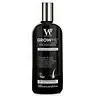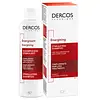What's inside
What's inside
 Key Ingredients
Key Ingredients

 Benefits
Benefits

 Concerns
Concerns

 Ingredients Side-by-side
Ingredients Side-by-side

Water
Skin ConditioningSodium C14-16 Olefin Sulfonate
CleansingCocamidopropyl Betaine
CleansingSodium Chloride
MaskingDisodium Laureth Sulfosuccinate
CleansingAcrylates Copolymer
Phenoxyethanol
PreservativePolyquaternium-10
Parfum
MaskingCitric Acid
BufferingPEG-150 Pentaerythrityl Tetrastearate
EmulsifyingHydrolyzed Lupine Protein
Skin ConditioningPolyquaternium-7
Argania Spinosa Kernel Oil
EmollientAllantoin
Skin ConditioningSodium Hydroxide
BufferingNiacinamide
SmoothingCaffeine
Skin ConditioningPEG-6 Caprylic/Capric Glycerides
EmulsifyingSodium Starch Octenylsuccinate
AbsorbentTetrasodium EDTA
Maltodextrin
AbsorbentStyrene/Vp Copolymer
Calcium Pantothenate
Silicone Quaternium-22
Ethylhexylglycerin
Skin ConditioningSodium Benzoate
MaskingSodium Ascorbyl Phosphate
AntioxidantDipropylene Glycol
HumectantPolyglyceryl-3 Caprate
EmulsifyingGlycerin
HumectantTocopheryl Acetate
AntioxidantPyridoxine Hcl
Skin ConditioningRosmarinus Officinalis Leaf Extract
AntimicrobialPalmitamidopropyltrimonium Chloride
Propylene Glycol
HumectantBiotin
AntiseborrhoeicSilica
AbrasiveSorbic Acid
PreservativePotassium Sorbate
PreservativeWater, Sodium C14-16 Olefin Sulfonate, Cocamidopropyl Betaine, Sodium Chloride, Disodium Laureth Sulfosuccinate, Acrylates Copolymer, Phenoxyethanol, Polyquaternium-10, Parfum, Citric Acid, PEG-150 Pentaerythrityl Tetrastearate, Hydrolyzed Lupine Protein, Polyquaternium-7, Argania Spinosa Kernel Oil, Allantoin, Sodium Hydroxide, Niacinamide, Caffeine, PEG-6 Caprylic/Capric Glycerides, Sodium Starch Octenylsuccinate, Tetrasodium EDTA, Maltodextrin, Styrene/Vp Copolymer, Calcium Pantothenate, Silicone Quaternium-22, Ethylhexylglycerin, Sodium Benzoate, Sodium Ascorbyl Phosphate, Dipropylene Glycol, Polyglyceryl-3 Caprate, Glycerin, Tocopheryl Acetate, Pyridoxine Hcl, Rosmarinus Officinalis Leaf Extract, Palmitamidopropyltrimonium Chloride, Propylene Glycol, Biotin, Silica, Sorbic Acid, Potassium Sorbate
Water
Skin ConditioningSodium Laureth Sulfate
CleansingCitric Acid
BufferingSodium Cocoamphoacetate
CleansingHexylene Glycol
EmulsifyingAmmonium Hydroxide
BufferingGlycol Distearate
EmollientCarbomer
Emulsion StabilisingCoco-Betaine
CleansingDiaminopyrimidine Oxide
Skin ConditioningIsopropyl Alcohol
SolventNiacinamide
SmoothingPanthenol
Skin ConditioningPEG-55 Propylene Glycol Oleate
Polyquaternium-10
Propylene Glycol
HumectantPyridoxine Hcl
Skin ConditioningSalicylic Acid
MaskingSodium Acetate
BufferingSodium Benzoate
MaskingSodium Chloride
MaskingSodium Hydroxide
BufferingParfum
MaskingWater, Sodium Laureth Sulfate, Citric Acid, Sodium Cocoamphoacetate, Hexylene Glycol, Ammonium Hydroxide, Glycol Distearate, Carbomer, Coco-Betaine, Diaminopyrimidine Oxide, Isopropyl Alcohol, Niacinamide, Panthenol, PEG-55 Propylene Glycol Oleate, Polyquaternium-10, Propylene Glycol, Pyridoxine Hcl, Salicylic Acid, Sodium Acetate, Sodium Benzoate, Sodium Chloride, Sodium Hydroxide, Parfum
Ingredients Explained
These ingredients are found in both products.
Ingredients higher up in an ingredient list are typically present in a larger amount.
Citric Acid is an alpha hydroxy acid (AHA) naturally found in citrus fruits like oranges, lemons, and limes.
Like other AHAs, citric acid can exfoliate skin by breaking down the bonds that hold dead skin cells together. This helps reveal smoother and brighter skin underneath.
However, this exfoliating effect only happens at high concentrations (20%) which can be hard to find in cosmetic products.
Due to this, citric acid is usually included in small amounts as a pH adjuster. This helps keep products slightly more acidic and compatible with skin's natural pH.
In skincare formulas, citric acid can:
While it can provide some skin benefits, research shows lactic acid and glycolic acid are generally more effective and less irritating exfoliants.
Most citric acid used in skincare today is made by fermenting sugars (usually from molasses). This synthetic version is identical to the natural citrus form but easier to stabilize and use in formulations.
Read more about some other popular AHA's here:
Learn more about Citric AcidNiacinamide is a multitasking form of vitamin B3 that strengthens the skin barrier, reduces pores and dark spots, regulates oil, and improves signs of aging.
And the best part? It's gentle and well-tolerated by most skin types, including sensitive and reactive skin.
You might have heard of "niacin flush", or the reddening of skin that causes itchiness. Niacinamide has not been found to cause this.
In very rare cases, some individuals may not be able to tolerate niacinamide at all or experience an allergic reaction to it.
If you are experiencing flaking, irritation, and dryness with this ingredient, be sure to double check all your products as this ingredient can be found in all categories of skincare.
When incorporating niacinamide into your routine, look out for concentration amounts. Typically, 5% niacinamide provides benefits such as fading dark spots. However, if you have sensitive skin, it is better to begin with a smaller concentration.
When you apply niacinamide to your skin, your body converts it into nicotinamide adenine dinucleotide (NAD). NAD is an essential coenzyme that is already found in your cells as "fuel" and powers countless biological processes.
In your skin, NAD helps repair cell damage, produce new healthy cells, support collagen production, strengthen the skin barrier, and fight environmental stressors (like UV and pollution).
Our natural NAD levels start to decline with age, leading to slower skin repair, visible aging, and a weaker skin barrier. By providing your skin niacinamide, you're recharging your skin's NAD levels. This leads to stronger, healthier, and younger looking skin.
Another name for vitamin B3 is nicotinamide. This vitamin is water-soluble and our bodies don't store it. We obtain Vitamin B3 from either food or skincare. Meat, fish, wheat, yeast, and leafy greens contain vitamin B3.
The type of niacinamide used in skincare is synthetically created.
Learn more about NiacinamideParfum is a catch-all term for an ingredient or more that is used to give a scent to products.
Also called "fragrance", this ingredient can be a blend of hundreds of chemicals or plant oils. This means every product with "fragrance" or "parfum" in the ingredients list is a different mixture.
For instance, Habanolide is a proprietary trade name for a specific aroma chemical. When used as a fragrance ingredient in cosmetics, most aroma chemicals fall under the broad labeling category of “FRAGRANCE” or “PARFUM” according to EU and US regulations.
The term 'parfum' or 'fragrance' is not regulated in many countries. In many cases, it is up to the brand to define this term.
For instance, many brands choose to label themselves as "fragrance-free" because they are not using synthetic fragrances. However, their products may still contain ingredients such as essential oils that are considered a fragrance by INCI standards.
One example is Calendula flower extract. Calendula is an essential oil that still imparts a scent or 'fragrance'.
Depending on the blend, the ingredients in the mixture can cause allergies and sensitivities on the skin. Some ingredients that are known EU allergens include linalool and citronellol.
Parfum can also be used to mask or cover an unpleasant scent.
The bottom line is: not all fragrances/parfum/ingredients are created equally. If you are worried about fragrances, we recommend taking a closer look at an ingredient. And of course, we always recommend speaking with a professional.
Learn more about ParfumPolyquaternium-10 is an ammonium salt of hydroxyethylcellulose. It is a white and granular powder used as a film-former and anti-static agent.
This ingredient is commonly found in hair conditioning products. According to a manufacturer, its positive charge makes it great for absorbing hair proteins. The manufacturer also states this ingredient helps with curl retention.
For haircare friends: this ingredient is not a silicone.
Learn more about Polyquaternium-10Propylene Glycol is an odorless, colorless liquid. As a humectant, it helps skin retain moisture. It also aids in delivering active ingredients.
Another role of this ingredient is preventing a product from melting or freezing. Propylene glycol also adds antimicrobrial properties to a product, elongating product lifespan.
This ingredient is considered an organic alcohol and commonly added into both cosmetics and foods.
Those with sensitive skin or conditions may develop a rash when using this ingredient.
Learn more about Propylene GlycolPyridoxine hydrochloride, also known as vitamin B6, has skin conditioning properties. According to a manufacturer, this ingredient is an effective anti-dandruff treatment as it reduces sebum levels and oily spots.
Sodium Benzoate is a preservative. It's used in both cosmetic and food products to inhibit the growth of mold and bacteria. It is typically produced synthetically.
Both the US FDA and EU Health Committee have approved the use of sodium benzoate. In the US, levels of 0.1% (of the total product) are allowed.
Sodium benzoate works as a preservative by inhibiting the growth of bacteria inside of cells. It prevents the cell from fermenting a type of sugar using an enzyme called phosphofructokinase.
It is the salt of benzoic acid. Foods containing sodium benzoate include soda, salad dressings, condiments, fruit juices, wines, and snack foods.
Studies for using ascorbic acid and sodium benzoate in cosmetics are lacking, especially in skincare routines with multiple steps.
We always recommend speaking with a professional, such as a dermatologist, if you have any concerns.
Learn more about Sodium BenzoateChances are, you eat sodium chloride every day. Sodium Chloride is also known as table salt.
This ingredient has many purposes in skincare: thickener, emulsifier, and exfoliator.
You'll most likely find this ingredient in cleansers where it is used to create a gel-like texture. As an emulsifier, it also prevents ingredients from separating.
There is much debate on whether this ingredient is comedogenic. The short answer - comedogenic ratings don't tell the whole story. Learn more about comegodenic ratings here.
The concensus about this ingredient causing acne seems to be divided. Research is needed to understand if this ingredient does cause acne.
Scrubs may use salt as the primary exfoliating ingredient.
Learn more about Sodium ChlorideSodium Hydroxide is also known as lye or caustic soda. It is used to adjust the pH of products; many ingredients require a specific pH to be effective.
In small amounts, sodium hydroxide is considered safe to use. However, large amounts may cause chemical burns due to its high alkaline.
Your skin has a natural pH and acid mantle. This acid mantle helps prevent harmful bacteria from breaking through. The acid mantle also helps keep your skin hydrated.
"Alkaline" refers to a high pH level. A low pH level would be considered acidic.
Learn more about Sodium HydroxideWater. It's the most common cosmetic ingredient of all. You'll usually see it at the top of ingredient lists, meaning that it makes up the largest part of the product.
So why is it so popular? Water most often acts as a solvent - this means that it helps dissolve other ingredients into the formulation.
You'll also recognize water as that liquid we all need to stay alive. If you see this, drink a glass of water. Stay hydrated!
Learn more about Water